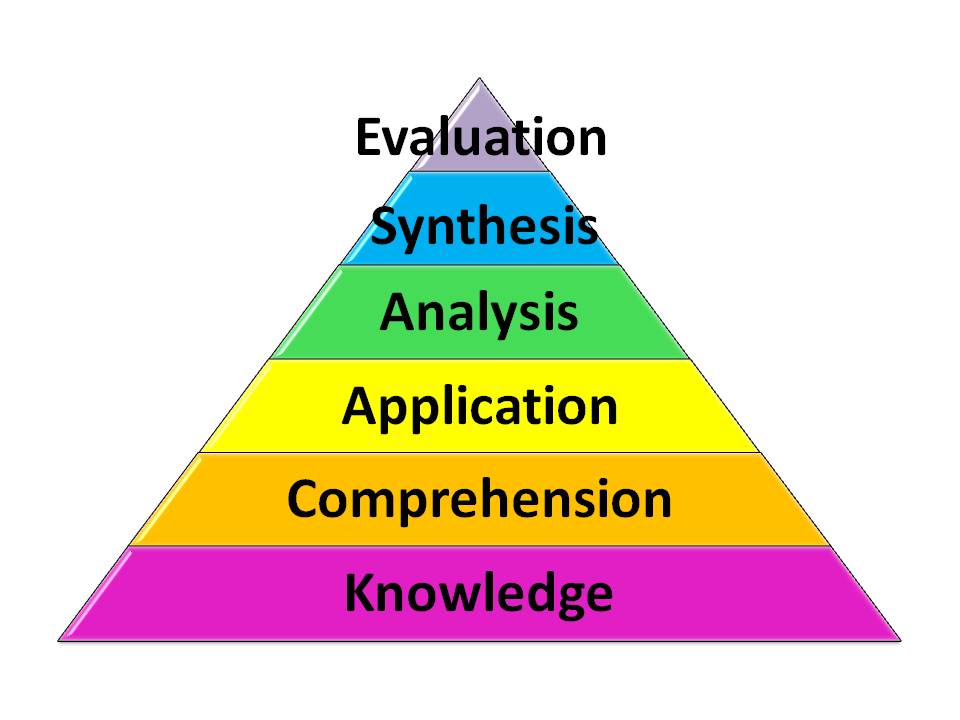Learning objectives can also be referred to as behavioral, instructional, or performance objectives, but in any case, a learning objective refers to an observable behavior or performance as the outcome of learning.
Learning objectives contain 3 components:
1. Condition - specify the circumstance, command, material, or direction given to initiate intended behavior
2. Behavior - Action desired (always a verb!)
3. Criterion - declarative statement to describe how well the behavior must be performed to satisy intent
Bloom's Taxonomoy (as seen below) is used to classify instructional activities based on their level of difficulty and is a great reference tool for writing learning objectives.
Here are some commonly used verbs for each of the six levels, listed in increasing order of the level of thinking skills required:
Knowledge- Define, Memorize, Repeat, Record, Label, Specify
Comprehension- Summarize, Describe, Explain, Identify, Translate
Application- Solve, Simulate, Apply, Illustrate, Exhibit
Analysis- Interpret, Compare, Categorize, Investigate, Discover
Synthesis- Plan, Imagine, Produce, Design, Predict
Evaluation- Judge, Assess, Measure, Conclude, Criticize
Resources:
NERC(2007) Guide to writing Learning Objectives. Retrieved from: http://www.nerc.com/files/Instructional_guide_writing_Objectives.pdf
Photo: http://www.odu.edu/educ/roverbau/Bloom/blooms_taxonomy.htm
Adult Learning and Training, eLearning Design and Development
Workforce Surveys, Human Resources, and Project Management
Wednesday, November 16, 2011
Saturday, November 12, 2011
Learning Tool: AdeLE
Adaptive eLearning with Eye-tracking
Adaptive eLearning is a hot topic right now. Perhaps you have heard it referred to as adaptive training, intelligent tutoring system (ITS), or cognitive tutor, but in any case, adaptive eLearning is a learning system that intelligently adapts learning content to suit learner needs via a computer.
To learn more about adaptive learning, there is a great video and adaptive learning samples posted on the Adaptive eLearning website at UNSW.
In this post, however, I would like to take adaptive eLearning to the next level and advocate for the use of real-time eye-tracking in combination with the content-analysis tracking used by basic adaptive eLearning systems.
Lead by a research team in Austria, a protoype for Adaptive eLearning with eye-tracking is being developed. It is aptly named "AdeLE".
Resources:
Pivec, M, Trummer, & C. Pripfl, J. (2006). Eye-Tracking Adaptable e-Learning and Content Authoring Support. Informatica, 30, 83-86
Al-Khalifa, H.S. & George, R.P. (2010) Eye Tracking and e-Learning: Seeing Through Your Students' Eyes. ELearn Magazine, June 2010.
Gütl, C., Pivec, M., Trummer, C., García-Barrios, V.M., Mödritscher, F., Pripfl, J., & Umgeher, M. (2005). AdeLE (Adaptive e-Learning with Eye-Tracking): Theoretical Background, System Architecture and Application Scenarios. EURRODL 12-05.
Adaptive eLearning is a hot topic right now. Perhaps you have heard it referred to as adaptive training, intelligent tutoring system (ITS), or cognitive tutor, but in any case, adaptive eLearning is a learning system that intelligently adapts learning content to suit learner needs via a computer.
To learn more about adaptive learning, there is a great video and adaptive learning samples posted on the Adaptive eLearning website at UNSW.
In this post, however, I would like to take adaptive eLearning to the next level and advocate for the use of real-time eye-tracking in combination with the content-analysis tracking used by basic adaptive eLearning systems.
Lead by a research team in Austria, a protoype for Adaptive eLearning with eye-tracking is being developed. It is aptly named "AdeLE".
Resources:
Pivec, M, Trummer, & C. Pripfl, J. (2006). Eye-Tracking Adaptable e-Learning and Content Authoring Support. Informatica, 30, 83-86
Al-Khalifa, H.S. & George, R.P. (2010) Eye Tracking and e-Learning: Seeing Through Your Students' Eyes. ELearn Magazine, June 2010.
Gütl, C., Pivec, M., Trummer, C., García-Barrios, V.M., Mödritscher, F., Pripfl, J., & Umgeher, M. (2005). AdeLE (Adaptive e-Learning with Eye-Tracking): Theoretical Background, System Architecture and Application Scenarios. EURRODL 12-05.
Subscribe to:
Posts (Atom)
